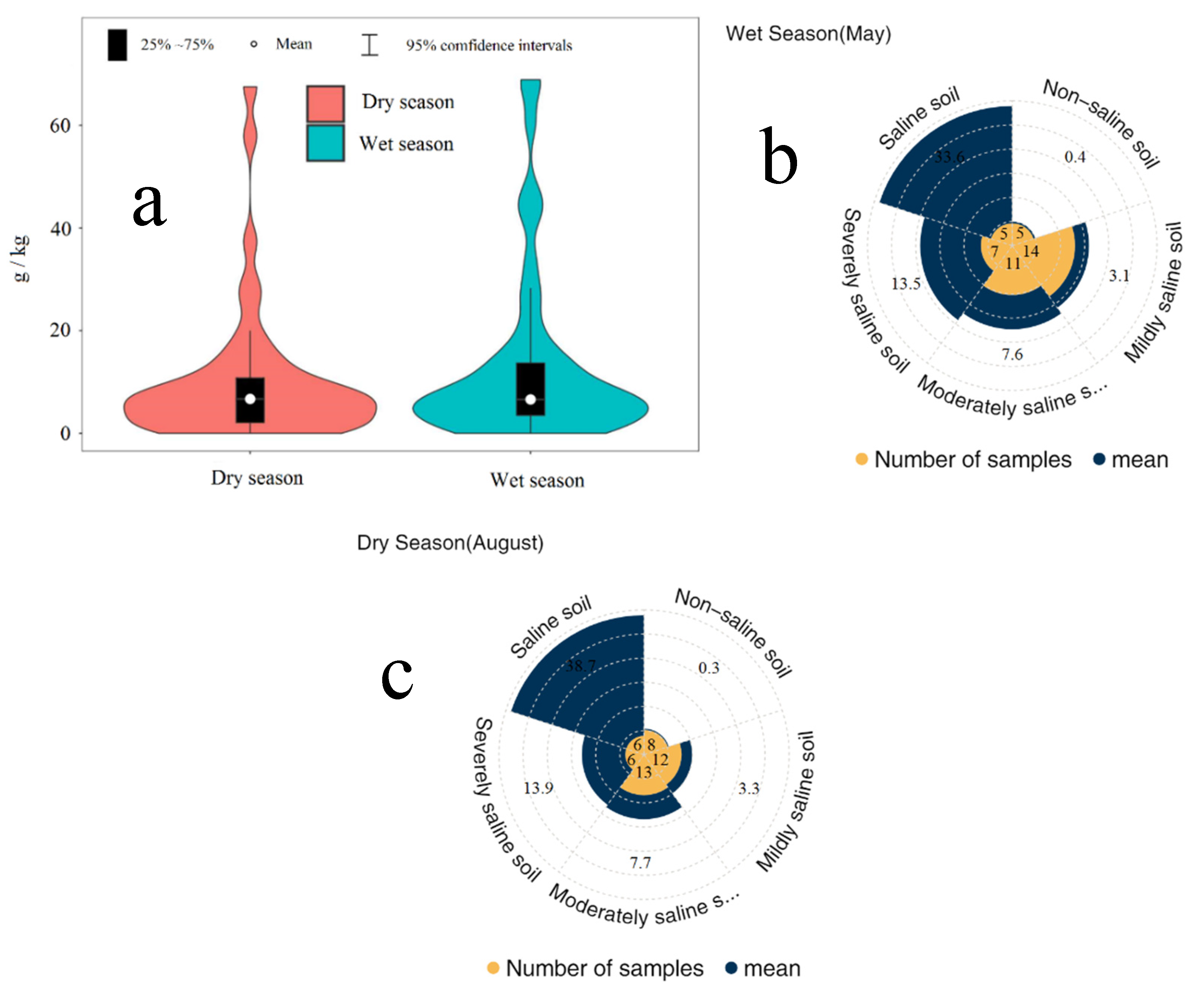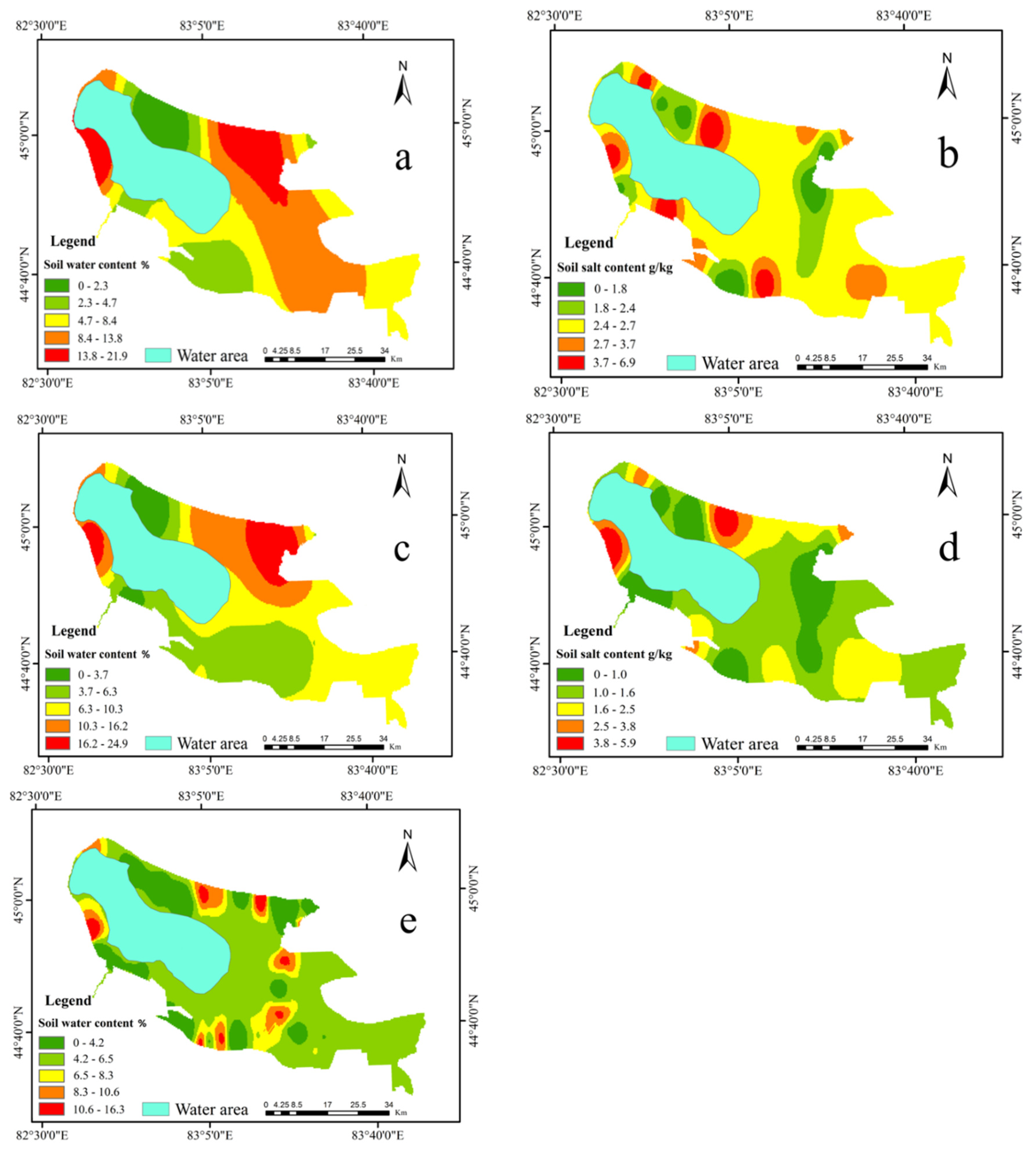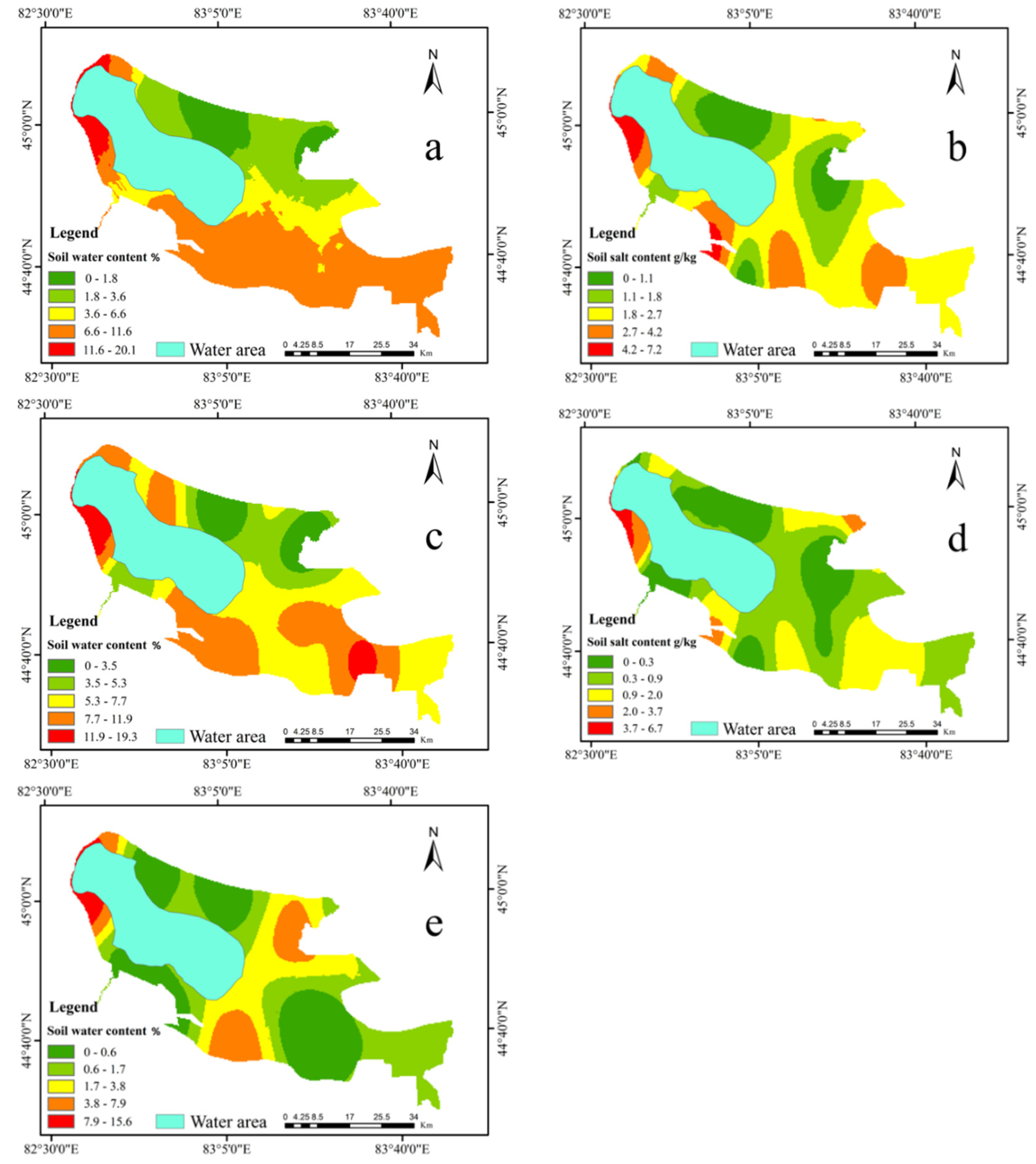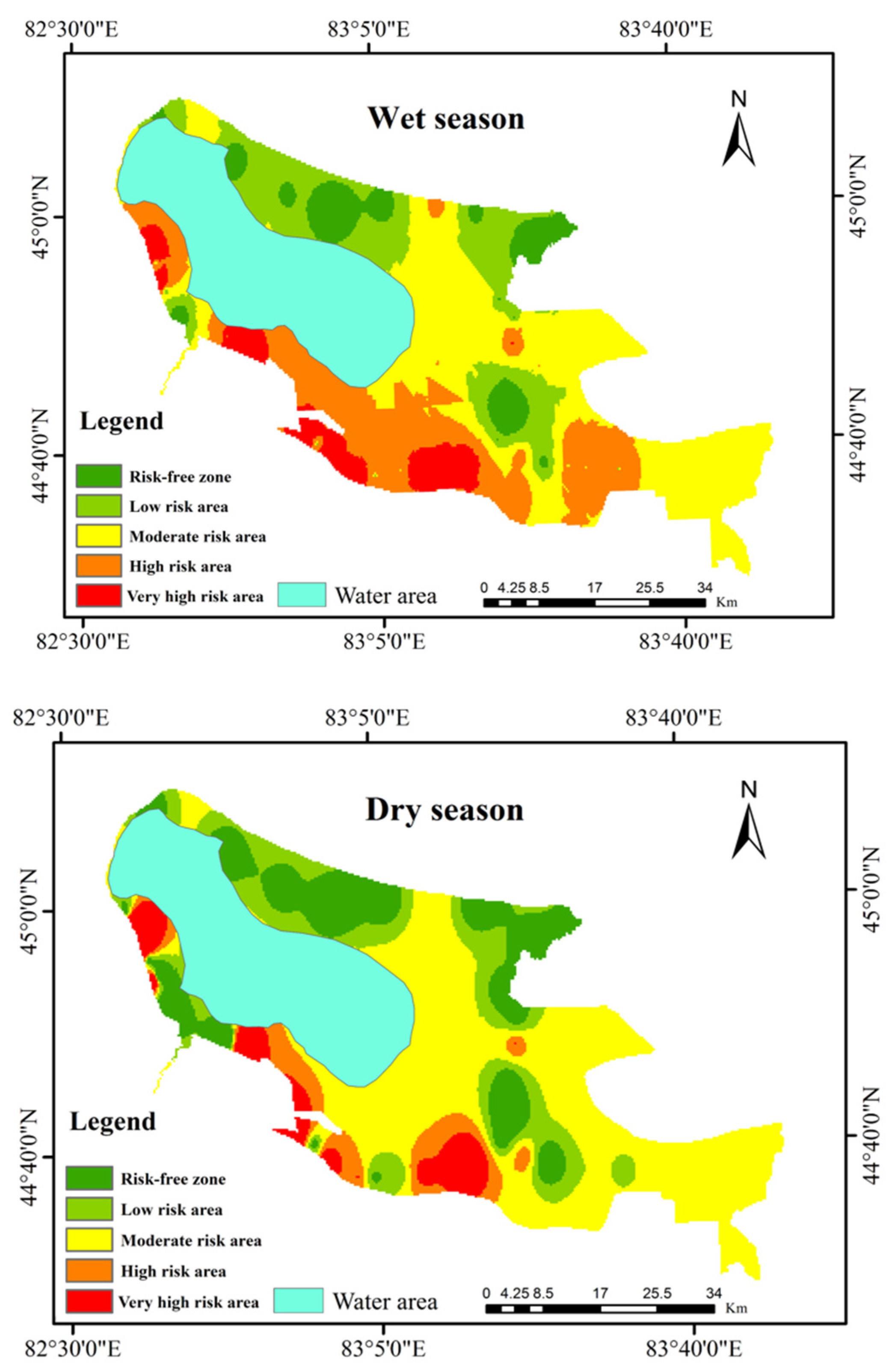Quantitative Evaluation of Spatial and Temporal Variation of Soil Salinization Risk Using GIS-Based Geostatistical Method
Abstract
:1. Introduction
2. Study Area
3. Data and Methodology
3.1. Investigation and Analysis of Field Data
3.2. Acquisition of Remote Sensing and Digital Elevation Model Data
3.3. Selection of Risk Sources for Salinization
3.4. Experimental Research Methods
3.4.1. Correlation Coefficient Analysis and Test Method
3.4.2. The Land Use Degree Index
3.4.3. Spatial Interpolation Method
3.4.4. Comprehensive Soil Salinization Grading Method
4. Results and Analysis
4.1. Statistical Analysis of Soil Samples
4.2. Spatial Distribution of Salinization Influencing Factors
4.2.1. Vector Factor Analysis
4.2.2. Remote Sensing Factor Analysis
4.3. Spatial Data Analysis
4.4. Risk Weighting Analysis of Driving Factors
4.5. Spatial Distribution and Accuracy Verification of Soil Salinization Risk
4.6. Soil Salinization Risk Transfer in Dry and Wet Season
5. Discussion
5.1. Influence of Lake Water Volume on Soil Salinization
5.2. Effects of Soil Salinity on Eco-Environment
5.3. Applicability of Risk Factors
6. Conclusions
- The correlation coefficients of risk assessment factors of salinization in the study area were obtained. During the wet season, the weighting factor of the soil salinization risk evaluation factor was greatest with the plant senescence reflectance index (PSRI), followed by the deep soil water content (D_wat) and the shallow soil salinity content (SH_sal). During the dry season, the weighting factor for the salinization risk evaluation factor was highest for shallow soil salinity content (SH_sal), followed by land use and land cover change (LUCC) and deep soil water content (D_wat).
- The risk of salinization differs between the wet and dry seasons in the study area. The wet season is characterized by a relatively high risk of salinization, mainly in the form of moderation risk, high risk, and very high risk. Among them, moderate-risk areas account for 36.96% of the ELWNNR area, followed by high-risk areas at 32.12%. In contrast, the dry season experiences mainly low to moderate risk of salinization. Among them, moderate-risk areas account for 57.79% of the protected area, followed by low-risk areas at 15.98%. These results show that the dry season is better for agricultural production than the wet season due to lower risk of soil salinity.
- From the Sankey diagram’s transfer matrix, it was found that, as the season moves from wet to dry (from May to August), moderate-risk area (in the wet season) shifts to low risk and risk-free (in the dry season). Similarly, the area of high risk in the wet season shifts to moderate risk in the dry season. This is mainly because the reduction in the volume of water in the lakes decreases the “water action” of the salt-accumulating environment from wet to dry seasons.
Supplementary Materials
Author Contributions
Funding
Acknowledgments
Conflicts of Interest
References
- Rengasamy, P. World salinization with emphasis on Australia. J. Exp. Bot. 2006, 57, 1017–1023. [Google Scholar] [CrossRef] [Green Version]
- D’Odorico, P.; Bhattachan, A.; Davis, K.F.; Ravi, S.; Runyana, C.W. Global desertification: Drivers and feedbacks. Adv. Water Res. 2013, 51, 326–344. [Google Scholar] [CrossRef]
- Barradas, J.M.M.; Abdelfattah, A.; Matula, S.; Dolezal, F. Effect of Fertigation on Soil Salinization and Aggregate Stability. J. Irrig. Drain. Eng. 2015, 141. [Google Scholar] [CrossRef]
- Li-Xian, Y.; Guo-Liang, L.; Shi-Hua, T.; Sulewski, G.; He, Z.H. Salinity of animal manure and potential risk of secondary soil salinization through successive manure application. Sci. Total Environ. 2007, 383, 106–114. [Google Scholar] [CrossRef] [PubMed]
- Shaddad, S.M.; Buttafuoco, G.; Castrignanò, A. Assessment and Mapping of Soil Salinization Risk in an Egyptian Field Using a Probabilistic Approach. Agronomy 2020, 10, 85. [Google Scholar] [CrossRef] [Green Version]
- Zhou, D.; Lin, Z.; Liu, L.; Zimmermann, D. Assessing secondary soil salinization risk based on the PSR sustainability framework. J. Environ. Manag. 2013, 128, 642–654. [Google Scholar] [CrossRef]
- Ali, R.R.; Abdel Kawy, W.A.M. Land degradation risk assessment of El Fayoum depression, Egypt. Arab. J. Geosci. 2012, 6, 2767–2776. [Google Scholar] [CrossRef]
- Castrignanò, A.; Buttafuoco, G.; Puddu, R. Multi-scale assessment of the risk of soil salinization in an area of south-eastern Sardinia (Italy). Precis. Agric. 2008, 9, 17–31. [Google Scholar] [CrossRef]
- Yang, J.X.; Zhao, J.; Zhu, G.F.; Wang, Y.; Ma, X.; Wang, J.; Guo, H.; Zhang, Y. Soil salinization in the oasis areas of downstream inland rivers -Case Study: Minqin oasis. Quat. Int. 2020, 537, 69–78. [Google Scholar] [CrossRef]
- Ayad, Y.A. Remote sensing and GIS in modeling visual landscape change: A case study of the northwestern and coast of Egypt. Landsc. Urban Plan. 2005, 73, 307–325. [Google Scholar] [CrossRef]
- Nas, B.; Berktay, A. Groundwater quality mapping in urban groundwater using GIS. Environ. Monit. Assess. 2010, 160, 215–227. [Google Scholar] [CrossRef] [PubMed]
- Wang, X.; Zhang, F.; Ding, J.; Latif, A.; Johnson, V.C. Estimation of soil salt content (SSC) in the Ebinur Lake Wetland National Nature Reserve (ELWNNR), Northwest China, based on a Bootstrap-BP neural network model and optimal spectral indices. Sci. Total Environ. 2018, 615, 918–930. [Google Scholar] [CrossRef]
- Chi, Y.; Sun, J.K.; Liu, W.Q.; Wang, J.; Zhao, M. Mapping coastal wetland soil salinity in different seasons using an improved comprehensive land surface factor system. Ecol. Indic. 2019, 107. [Google Scholar] [CrossRef]
- Solangi, K.A.; Siyal, A.A.; Wu, Y.Y.; Abbasi, B.; Solangi, F.; Ali Lakhiar, I.; Zhou, G. An Assessment of the Spatial and Temporal Distribution of Soil Salinity in Combination with Field and Satellite Data: A Case Study in Sujawal District. Agronomy 2019, 9, 869. [Google Scholar] [CrossRef] [Green Version]
- Ren, D.Y.; Wei, B.Y.; Xu, X.; Engel, B.; Li, G.; Huang, Q.; Xiong, Y.; Huang, G. Analyzing spatiotemporal characteristics of soil salinity in arid irrigated agro-ecosystems using integrated approaches. Geoderma 2019, 356, 113935. [Google Scholar] [CrossRef]
- Seydehmet, J.; Lv, G.-H.; Abliz, A.; Shi, Q.D.; Abliz, A.; Turup, A. Irrigation Salinity Risk Assessment and Mapping in Arid Oasis, Northwest China. Water 2018, 10, 966. [Google Scholar] [CrossRef] [Green Version]
- Abou Samra, R.M.; Ali, R.R. The development of an overlay model to predict soil salinity risks by using remote sensing and GIS techniques: A case study in soils around Idku Lake, Egypt. Environ. Monit. Assess 2018, 190, 706. [Google Scholar] [CrossRef]
- Zhaoyong, Z.; Abuduwaili, J.; Yimit, H. The occurrence, sources and spatial characteristics of soil salt and assessment of soil salinization risk in Yanqi basin, northwest China. PLoS ONE 2014, 9, e106079. [Google Scholar] [CrossRef]
- Libutti, A.; Cammerino, A.; Monteleone, M. Risk Assessment of Soil Salinization Due to Tomato Cultivation in Mediterranean Climate Conditions. Water 2018, 10, 1503. [Google Scholar] [CrossRef] [Green Version]
- Abuduwailli, J.; Gabchenko, M.V.; Xu, J. Eolian transport of salts—A case study in the area of Lake Ebinur (Xinjiang, Northwest China). J. Arid Environ. 2008, 72, 1843–1852. [Google Scholar] [CrossRef]
- Liu, D.; Abuduwaili, J.; Wang, L. Salt dust storm in the Ebinur Lake region: Its 50-year dynamic changes and response to climate changes and human activities. Nat. Hazards 2015, 77, 1069–1080. [Google Scholar] [CrossRef]
- Wang, J.; Ding, J.; Abulimiti, A.; Cai, L. Quantitative estimation of soil salinity by means of different modeling methods and visible-near infrared (VIS-NIR) spectroscopy, Ebinur Lake Wetland, Northwest China. PeerJ 2018, 6. [Google Scholar] [CrossRef] [PubMed] [Green Version]
- Zhou, J.; Wu, J.; Ma, L.; Qiang, M. Late Quaternary lake-level and climate changes in arid central Asia inferred from sediments of Ebinur Lake, Xinjiang, northwestern China. Quat. Res. 2019, 92, 416–429. [Google Scholar] [CrossRef]
- Water Resources Department of Xinjiang Uygur Autonomous Region. Work Outline of County-Level Saline-Alkali Land Improvement and Utilization Planning in Xinjiang; Water Resources Department of Xinjiang Uygur Autonomous Region: Urumqi, China, 2005.
- Bakr, N.; Ali, R.R. Statistical relationship between land surface altitude and soil salinity in the enclosed desert depressions of arid regions. Arab. J. Geosci. 2019, 12. [Google Scholar] [CrossRef]
- Chen, T.; Niu, R.; Li, P.; Zhang, L.; Du, B. Regional soil erosion risk mapping using RUSLE, GIS, and remote sensing: A case study in Miyun Watershed, North China. Environ. Earth Sci. 2010, 63, 533–541. [Google Scholar] [CrossRef]
- Buchanan, S.; Huang, J.; Triantafilis, J. Salinity risk assessment using fuzzy multiple criteria evaluation. Soil Use Manag. 2017, 33, 216–232. [Google Scholar] [CrossRef]
- Wang, Z.; Fan, B.; Guo, L. Soil salinization after long-term mulched drip irrigation poses a potential risk to agricultural sustainability. Eur. J. Soil Sci. 2019, 70, 20–24. [Google Scholar] [CrossRef] [Green Version]
- French, A.N.; Norman, J.M.; Anderson, M.C. A simple and fast atmospheric correction for spacebome remote sensing of surface temperature. Remote Sens. Environ. 2003, 87, 326–333. [Google Scholar] [CrossRef]
- Chen, Z.; Wang, J. Landslide hazard mapping using logistic regression model in Mackenzie Valley, Canada. Nat. Hazards 2007, 42, 75–89. [Google Scholar] [CrossRef]
- Defries, R.S.; Townshend, J.R.G. NDVI-derived land cover classifications at a global scale. Int. J. Remote Sens. 2007, 15, 3567–3586. [Google Scholar] [CrossRef]
- Ren, S.; Chen, X.; An, S. Assessing plant senescence reflectance index-retrieved vegetation phenology and its spatiotemporal response to climate change in the Inner Mongolian Grassland. Int. J. Biometeorol. 2017, 61, 601–612. [Google Scholar] [CrossRef] [PubMed]
- Nutini, F.; Boschetti, M.; Brivio, P.A.; Natarajan, S.; Sivasamy, R.; Poongodi, C. Land-use and land-cover change detection in a semi-arid area of Niger using multi-temporal analysis of Landsat images. Int. J. Remote Sens. 2013, 34, 4769–4790. [Google Scholar] [CrossRef]
- Rodenbeck, C.; Houweling, S.; Gloor, M.; Heimann, M. CO2 flux history 1982–2001 inferred from atmospheric data using a global inversion of atmospheric transport. Atmos. Chem. Phys. 2003, 3, 1919–1964. [Google Scholar] [CrossRef] [Green Version]
- Pum, J.K.W. Evaluating sample stability in the clinical laboratory with the help of linear and non-linear regression analysis. Clin. Chem. Lab. Med. 2020, 58, 188–196. [Google Scholar] [CrossRef] [PubMed]
- Guo, Q.; Luo, L.; Zhao, H.; Pan, Y.; Bing, Q. Study on Spatio-Temporal Change of Land Use in Tianjin Urban Based on Remote Sensing Data. Commun. Comput. Inf. Sci. 2016, 228–237. [Google Scholar] [CrossRef]
- Mulder, V.L.; de Bruin, S.; Schaepman, M.E.; Mayr, T.R. The use of remote sensing in soil and terrain mapping—A review. Geoderma 2011, 162, 1–19. [Google Scholar] [CrossRef]
- Webster, R.; Oliver, M. Geostatistics for Environmental Scientists; John Wiley & Sons: Chichester, UK, 2007; p. 330. ISBN 9780470028582. [Google Scholar]
- Castrignano, A.; Giugliarini, L.; Risaliti, R.; Martinelli, N. Study of spatial relationships among some soil physico-chemical properties of a field in central Italy using multivariate geostatistics. Geoderma 2000, 97, 39–60. [Google Scholar] [CrossRef]
- Mohanty, M.; Painuli, D.K.; Misra, A.K.; Ghosh, P.K. Soil quality effects of tillage and residue under rice-wheat cropping on a Vertisol in India. Soil Tillage Res. 2007, 92, 243–250. [Google Scholar] [CrossRef]
- Ceccato, P.; Flasse, S.; Tarantola, S.; Jacquemoud, S.; Grégoire, J.-M. Detecting vegetation leaf water content using reflectance in the optical domain. Remote Sens. Environ. 2001, 77, 22–33. [Google Scholar] [CrossRef]
- Chaves, M.M.; Flexas, J.; Pinheiro, C.; Novitskaya, L.; Foyer, C.H. Photosynthesis under drought and salt stress: Regulation mechanisms from whole plant to cell. Ann. Bot. 2009, 103, 551–560. [Google Scholar] [CrossRef] [Green Version]
- Zhang, Z.; Liu, M.; Liu, X.; Zhou, G. A New Vegetation Index Based on Multitemporal Sentinel-2 Images for Discriminating Heavy Metal Stress Levels in Rice. Sensors 2018, 18, 2172. [Google Scholar] [CrossRef] [Green Version]
- Ilyas, N.; Shi, Q.D.; Abdulla, A.; Xia, N.; Wang, J. Quantitative evaluation of soil salinization risk in Keriya Oasis based on grey evaluation model. Trans. Chin. Soc. Agric. Eng. 2019, 35, 176–184. (In Chinese) [Google Scholar]
- Weng, Q.H.; Lu, D.S.; Schubring, J. Estimation of land surface temperature-vegetation abundance relationship for urban heat island studies. Remote Sens. Environ. 2004, 89, 467–483. [Google Scholar] [CrossRef]
- Foody, G.M. Status of land cover classification accuracy assessment. Remote Sens. Environ. 2002, 80, 185–201. [Google Scholar] [CrossRef]
- Wang, J.; Ding, J.; Li, G.; Liang, J.; Yu, D.; Asishan, T.; Zhang, F.; Yang, J.; Abulimiti, A.; Liu, J. Dynamic detection of water surface area of Ebinur Lake using multi-source satellite data (Landsat and Sentinel-1A) and its responses to changing environment. Catena 2019, 177, 189–201. [Google Scholar] [CrossRef]
- Scanlon, B.R.; Keese, K.E.; Flint, A.L.; Flint, L.E.; Gaye, C.B.; Edmunds, W.M.; Simmers, I. Global synthesis of groundwater recharge in semiarid and arid regions. Hydrol. Process. 2006, 20, 3335–3370. [Google Scholar] [CrossRef]
- Wijitkosum, S.; Sriburi, T. Fuzzy AHP Integrated with GIS Analyses for Drought Risk Assessment: A Case Study from Upper Phetchaburi River Basin, Thailand. Water 2019, 11, 939. [Google Scholar] [CrossRef] [Green Version]
- Wiebe, B.H.; Eilers, R.G.; Eilers, W.D.; Brierley, J.A. Application of a risk indicator for assessing trends in dryland salinization risk on the Canadian Prairies. Can. J. Soil Sci. 2007, 87, 213–224. [Google Scholar] [CrossRef]
- Yang, J.M.; Ma, L.G.; Li, C.Z.; Liu, Y.; Ding, J.L.; Yang, S.T. Temporal-spatial variations and influencing factors of Lakes in inland arid areas from 2000 to 2017: A case study in Xinjiang. Geomat. Nat. Hazards Risk 2019, 10, 519–543. [Google Scholar] [CrossRef]
- Gorji, T.; Sertel, E.; Tanik, A. Monitoring soil salinity via remote sensing technology under data scarce conditions: A case study from Turkey. Ecol. Indic. 2017, 74, 384–391. [Google Scholar] [CrossRef]
- Rozema, J.; Flowers, T. Ecology Crops for a Salinized World. Science 2008, 322, 1478–1480. [Google Scholar] [CrossRef] [PubMed]
- Ramoliya, P.J.; Pandey, A.N. Effect of salinization of soil on emergence, growth and survival of Albizzia lebbek seedlings. Trop. Ecol. 2006, 47, 27–36. [Google Scholar] [CrossRef]











| Degree of Soil Salinization | Non-Saline Soil | Mildly Saline Soil | Moderately Saline Soil | Severely Saline Soil | Saline Soil |
|---|---|---|---|---|---|
| soil salt content g/kg | <1 | 1–6 | 6–10 | 10–20 | >20 |
| Salinization Risk Source | Abbreviations | Unit | Data Sources | Data Acquisition | Resolution of the Data | Data Type | Reference |
|---|---|---|---|---|---|---|---|
| Surface temperature | S_tem | °C | Landsat-8 OLI | Inversion | 30 m | Vector data | [29] |
| Surface elevation | S_ele | m | Field acquisition | Spatial interpolation | - | Vector data | [30] |
| Surface slope | S_slo | % | DEM | Inversion | 12 m | Raster data | [30] |
| Surface aspect | S_asp | - | DEM | Inversion | 12 m | Raster data | [30] |
| Normalized differential vegetation index | NDVI | - | Sentinel-2 MSI | Inversion | 10 m | Raster data | [31] |
| Plant senescence reflectance index | PSRI | - | Sentinel-2 MSI | Inversion | 20 m | Raster data | [32] |
| Land-Use and Land-Cover Change | LUCC | - | Sentinel-2 MSI | Inversion | 10 m | Raster data | [33] |
| Surface soil water content | S_wat | % | Field acquisition | Spatial interpolation | - | Vector data | |
| Soil salt content at shallow depths | SH_sal | g/kg | Field acquisition | Spatial interpolation | - | Vector data | |
| Soil water content at shallow depths | SH_wat | % | Field acquisition | Spatial interpolation | - | Vector data | |
| Soil salt content at deep depths | D_sal | g/kg | Field acquisition | Spatial interpolation | - | Vector data | |
| Soil water content at deep depths | D_wat | % | Field acquisition | Spatial interpolation | Vector data |
| May 2018 (Wet Season) | ||||||
| Salinization Risk Source | Mean | Median | Standard deviation | Variance | Minimum | Maximum |
| S_sal | 8.44 | 6.8 | 7.94 | 63.14 | 0.1 | 64.4 |
| S_ele | 219.85 | 207.5 | 65.86 | 438.61 | 182 | 269 |
| S_wat | 6.92 | 3.46 | 15.03 | 26.03 | 0.28 | 16.54 |
| S_slo | 1.25 | 1.08 | 1.13 | 1.29 | 0 | 4.76 |
| S_asp | 143.15 | 112.5 | 136.28 | 18,572.86 | −1 | 353.66 |
| LUCC | 4.33 | 5 | 1.09 | 1.2 | 2 | 5 |
| PSRI | 0.18 | 0.16 | 0.04 | 0.002 | 0.14 | 0.31 |
| NDVI | 0.38 | 0.34 | 0.12 | 0.015 | 0.29 | 0.78 |
| S_tem | 49.13 | 51.31 | 5.59 | 31.29 | 32.58 | 55.13 |
| SH_sal | 2.59 | 2.3 | 1.80 | 3.27 | 0 | 6.9 |
| D_sal | 2.07 | 1.95 | 1.48 | 2.19 | 0 | 5.9 |
| SH_wat | 7.09 | 6.56 | 4.87 | 23.74 | 0.35 | 21.93 |
| D_wat | 8.86 | 8.10 | 5.80 | 33.72 | 0.51 | 24.93 |
| August 2018 (Dry Season) | ||||||
| Salinization Risk Source | Mean | Median | Standard Deviation | Variance | Minimum | Maximum |
| S_sal | 10.18 | 6.7 | 13.46 | 181.28 | 0 | 62 |
| S_ele | 211.91 | 205 | 24.74 | 612.35 | 187 | 289 |
| S_wat | 3.23 | 2.09 | 3.43 | 11.79 | 0.02 | 15.64 |
| S_slo | 1.37 | 0.95 | 1.29 | 1.68 | 0 | 4.76 |
| S_asp | 153.81 | 135 | 127.21 | 16,184 | −1 | 355.66 |
| LUCC | 4.24 | 5 | 1.13 | 1.28 | 2 | 5 |
| PSRI | 0.04 | 0.02 | 0.06 | 0.004 | −0.03 | 0.29 |
| NDVI | 0.12 | 0.09 | 0.12 | 0.016 | 0.01 | 0.59 |
| S_tem | 31.29 | 31.61 | 3.14 | 9.9 | 24.91 | 37.14 |
| SH_sal | 2.57 | 2.2 | 2 | 4.015 | 0 | 7.2 |
| D_sal | 2.02 | 1.8 | 1.62 | 2.65 | 0 | 6.7 |
| SH_wat | 5.74 | 4.73 | 4.46 | 19.92 | 0.52 | 20.02 |
| D_wat | 8.79 | 6.65 | 12.75 | 162.7 | 0.32 | 35.87 |
| Wet Season | Dry Season | |||||
|---|---|---|---|---|---|---|
| Correlation Value | Absolute Value | Weight % | Correlation Value | Absolute Value | Weight % | |
| S_ele | −0.026 | 0.026 | 1.19 | −0.076 | 0.076 | 3.50 |
| S_wat | −0.107 | 0.107 | 4.92 | 0.065 | 0.065 | 2.99 |
| S_slo | −0.026 | 0.026 | 1.19 | −0.058 | 0.058 | 2.67 |
| S_asp | −0.128 | 0.128 | 5.88 | −0.153 | 0.153 | 7.04 |
| LUCC | −0.223 | 0.223 | 10.25 | −0.292 | 0.292 | 13.45 |
| PSRI | 0.304 | 0.304 | 13.98 | 0.158 | 0.158 | 7.27 |
| NDVI | 0.255 | 0.255 | 11.72 | 0.146 | 0.146 | 6.72 |
| S_tem | −0.175 | 0.175 | 8.04 | 0.13 | 0.13 | 5.98 |
| SH_wat | 0.246 | 0.246 | 11.31 | 0.147 | 0.147 | 6.77 |
| D_wat | 0.287 | 0.287 | 13.20 | 0.289 | 0.289 | 13.31 |
| SH_sal | 0.279 | 0.279 | 12.83 | 0.396 | 0.396 | 18.24 |
| D_sal | 0.118 | 0.118 | 5.42 | 0.261 | 0.261 | 12.02 |
| Account | 2.174 | 1 | 2.171 | 1 | ||
| Risk Level | Degree of Risk | Risk-Value Range | Wet Season | Dry Season | ||
|---|---|---|---|---|---|---|
| Acreage/m2 | Proportion of Area/% | Acreage/m2 | Proportion of Area/% | |||
| 1 | Risk-free area | <0.1 | 301.14 | 8.86 | 477.06 | 14.04 |
| 2 | Low-risk area | 0.1–0.3 | 405.03 | 11.92 | 542.9 | 15.98 |
| 3 | Moderate-risk area | 0.3–0.4 | 1255.27 | 36.96 | 1962.7 | 57.79 |
| 4 | High-risk area | 0.4–0.5 | 1090.9 | 32.12 | 245.5 | 7.22 |
| 5 | Very high-risk area | >0.5 | 343.9 | 10.12 | 168.05 | 4.94 |
| 3396.24 | 1 | 3396.21 | 1 | |||
| Number | Mean Value of S_sal | Standard Deviation of S_sal | Mean Value of SQ | Standard Deviation of SQ | Correlation |
|---|---|---|---|---|---|
| 87 | 9.7968 | 12.68 | 0.46 | 0.28 | 0.703 ** |
© 2020 by the authors. Licensee MDPI, Basel, Switzerland. This article is an open access article distributed under the terms and conditions of the Creative Commons Attribution (CC BY) license (http://creativecommons.org/licenses/by/4.0/).
Share and Cite
Wang, Z.; Zhang, F.; Zhang, X.; Chan, N.W.; Kung, H.-t.; Zhou, X.; Wang, Y. Quantitative Evaluation of Spatial and Temporal Variation of Soil Salinization Risk Using GIS-Based Geostatistical Method. Remote Sens. 2020, 12, 2405. https://doi.org/10.3390/rs12152405
Wang Z, Zhang F, Zhang X, Chan NW, Kung H-t, Zhou X, Wang Y. Quantitative Evaluation of Spatial and Temporal Variation of Soil Salinization Risk Using GIS-Based Geostatistical Method. Remote Sensing. 2020; 12(15):2405. https://doi.org/10.3390/rs12152405
Chicago/Turabian StyleWang, Zheng, Fei Zhang, Xianlong Zhang, Ngai Weng Chan, Hsiang-te Kung, Xiaohong Zhou, and Yishan Wang. 2020. "Quantitative Evaluation of Spatial and Temporal Variation of Soil Salinization Risk Using GIS-Based Geostatistical Method" Remote Sensing 12, no. 15: 2405. https://doi.org/10.3390/rs12152405
APA StyleWang, Z., Zhang, F., Zhang, X., Chan, N. W., Kung, H.-t., Zhou, X., & Wang, Y. (2020). Quantitative Evaluation of Spatial and Temporal Variation of Soil Salinization Risk Using GIS-Based Geostatistical Method. Remote Sensing, 12(15), 2405. https://doi.org/10.3390/rs12152405









